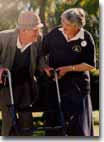
Stepping out with confidence
Specialist mobility instructors at the Association assist people who are
blind and vision impaired to use aids, such as a cane or a guide dog, to assist them to move around with confidence.
Aids to Mobility
There are a number of ways for people who are vision impaired to move about safely and independently:
Sighted Guide
Almost every vision impaired person travels with a sighted person at some time.For some vision impaired people assistance from a sighted person is not necessary, however, it is important to
recognise that individuals may need a guide at some time. It is always best to ask first, to find out whether or not the person needs a sighted guide.
The arm grip is the basis of the sighted guide technique. The vision impaired person grips the guide's upper arm just above the elbow. Common sense makes it work, but there are two rules to remember:
 The vision impaired person always takes the guide's arm. Body movement leads the
vision-impaired person and gives directional cues.
The vision impaired person always takes the guide's arm. Body movement leads the
vision-impaired person and gives directional cues.
 The guide goes first. This allows the vision impaired person to use the guide's body
language to obtain information on the immediate environment. The guide's body acts as protection for the vision impaired person who feels safer.
The guide goes first. This allows the vision impaired person to use the guide's body
language to obtain information on the immediate environment. The guide's body acts as protection for the vision impaired person who feels safer.
Click here for more detailed instructions on sighted guide technique
Canes
Richard Hoover, a physical education teacher at the Maryland School, devised the long cane (or white cane) for the Blind in the United States of America in the 1940's. It was introduced to Australia in 1963.
The length of the long cane is matched to the length of the stride of the individual. The cane is considered an extension of the index finger and is used to probe the environment in front, enabling the user to avoid any obstacles or changes of level (eg. steps up or down). As the tip of the cane touches the object first, the person has enough time to stop moving forward.
Some people can see well enough to travel independently with no training, but need either a support cane if their balance is not good, or a white cane for identifying their vision impairment to other
people, such as bus drivers or shop assistants.
Electronic devices
A variety of electronic mobility devices can be used in conjunction with either a long cane or a guide dog.
Guide Dogs
The Association also provides guide dogs within Western Australia.
Follow this link for more detailed information on our guide dog services
Low Vision Aids
A variety of Low Vision Aids are available from the Association's Low Vision clinics. The most commonly used low vision aid for mobility purposes is a
monocular telescope (half a binocular) - a small hand-held device that magnifies an image in the distance.
© Copyright 2004. The Association for the Blind of W.A. (Inc.)
This page was last modified on Tuesday, 14 September, 2004